Discover the ultimate Varanasi travel guide 2025-2026. Learn the best time to visit Varanasi, top attractions, local experiences, and practical tips for an unforgettable journey to India’s holiest city.
Introduction: Understanding Varanasi’s Spiritual Significance
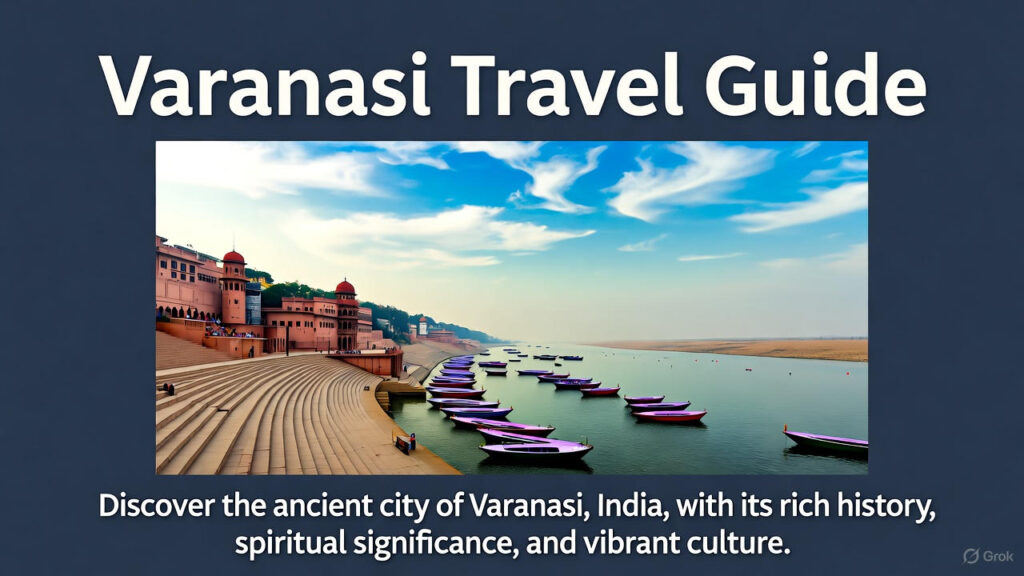
Varanasi, often called the spiritual capital of India, sits majestically along the banks of the sacred Ganges River. This ancient city, with its roots stretching back thousands of years, continues to captivate millions of pilgrims and travelers annually. The Varanasi travel guide serves as your compass to navigating one of the world’s oldest continuously inhabited cities, where spirituality, culture, and history intertwine seamlessly.
The city’s significance in Hinduism cannot be overstated. Hindus believe that dying in Varanasi and being cremated on its ghats grants moksha, or liberation from the cycle of rebirth. This profound spiritual calling has shaped the city’s character, making it a place where life’s most sacred moments unfold daily. Whether you’re seeking spiritual awakening, cultural immersion, or historical exploration, Varanasi offers an experience that transforms visitors profoundly.
Beyond its religious importance, Varanasi represents an extraordinary tapestry of Indian culture. The narrow, winding alleys reveal hidden temples, traditional markets, and local artisans preserving centuries-old crafts. The city’s energy is palpable, from the morning prayers echoing across the river to the evening aarti ceremonies that light up the ghats with thousands of oil lamps. Understanding Varanasi means appreciating how the sacred and the everyday coexist in remarkable harmony.
Modern travelers planning a Varanasi travel guide experience will find that the city beautifully balances ancient traditions with contemporary conveniences. Tourist infrastructure has developed significantly, making it accessible while maintaining its authentic character. From luxury hotels to budget hostels, from organized tours to independent exploration, Varanasi accommodates diverse travel preferences and budgets.
The city welcomes approximately 3.7 million visitors annually, with numbers trending upward. This growing interest reflects Varanasi’s universal appeal—it’s not exclusively for religious pilgrims anymore. Adventure seekers, cultural enthusiasts, photographers, and spiritual explorers find their own reasons to visit. Each visitor creates a unique connection with the city, taking away memories that linger long after departure.
Best Time to Visit Varanasi: Seasonal Guide
Choosing when to visit Varanasi significantly impacts your travel experience. The best time to visit Varanasi spans from October through March, when weather conditions are most favorable for exploration and outdoor activities. Understanding seasonal variations helps you plan accordingly and maximize your journey.
October to November: Autumn Season
Autumn marks the onset of pleasant weather in Varanasi. Temperatures range from 25-35°C (77-95°F), providing comfortable conditions for walking through the city’s maze-like streets. October, particularly, sees the Diwali festival, when the city transforms into a spectacular display of lights and festivities. Hotels offer special packages during this period, though advance bookings are essential.
The monsoon rains have ceased, leaving the Ganges full and pristine. The humidity decreases noticeably, making early morning walks along the ghats thoroughly enjoyable. Monsoon mist occasionally creates ethereal landscapes, particularly during sunrise, offering photographers stunning opportunities. This season attracts a moderate crowd, striking a balance between experiencing authentic Varanasi and managing tourist volumes.
December to February: Winter Season
Winter represents the peak tourist season in Varanasi. Daytime temperatures hover around 18-25°C (64-77°F), while nights can dip to 8-12°C (46-54°F). These cool, crisp mornings are ideal for aarti ceremonies and boat rides on the Ganges. The clear skies offer excellent photography conditions, and the water temperature becomes refreshing rather than cold.
During this period, multiple festivals enliven the city. Makar Sankranti in January draws massive crowds to the ghats for ritual bathing. The Varanasi International Music Festival showcases classical Indian music, attracting musicians and enthusiasts globally. However, expect significant tourist crowds, higher accommodation prices, and necessary early bookings. If you prefer a more intimate experience, consider late January or early February when crowds moderate slightly.
March to May: Summer Season
Summer in Varanasi brings intense heat, with temperatures soaring to 40-45°C (104-113°F) by May. However, this season offers advantages that shouldn’t be dismissed. Tourist numbers drop substantially, resulting in lower prices and better hotel availability. The spiritual atmosphere remains undiluted, and you’ll experience more authentic interactions with locals who aren’t overwhelmed by visitors.
Early morning exploration becomes essential during summer months. Most activities should commence before 9 AM, and afternoon rest is advisable. The riverbanks feel less crowded, allowing for peaceful contemplation. Many spiritual seekers intentionally visit during this season, making it ideal for yoga retreats, meditation courses, and deep spiritual practice.
June to September: Monsoon Season
Monsoon season transforms Varanasi dramatically. Heavy rainfall limits outdoor activities and makes navigating narrow alleyways challenging due to waterlogging. Many tourists avoid this period, resulting in significantly fewer visitors and lower prices. Hotels offer substantial discounts, and you can book accommodations easily.
Despite challenges, monsoon Varanasi holds its own magic. The green landscape becomes incredibly lush, the Ganges swells with life-giving waters, and spiritual energy intensifies. Fewer tourists mean you’ll experience a more authentic, less commercialized Varanasi. Waterproof clothing, reliable umbrellas, and flexible scheduling are essential. Respiratory conditions might be aggravated by increased moisture and mold, so those with such concerns should consider alternative seasons.
Top Attractions & Spiritual Sites in Varanasi
Varanasi boasts countless attractions, but certain sites demand priority on any comprehensive Varanasi travel guide. These locations embody the city’s spiritual essence and cultural significance.
Dashashwamedh Ghat
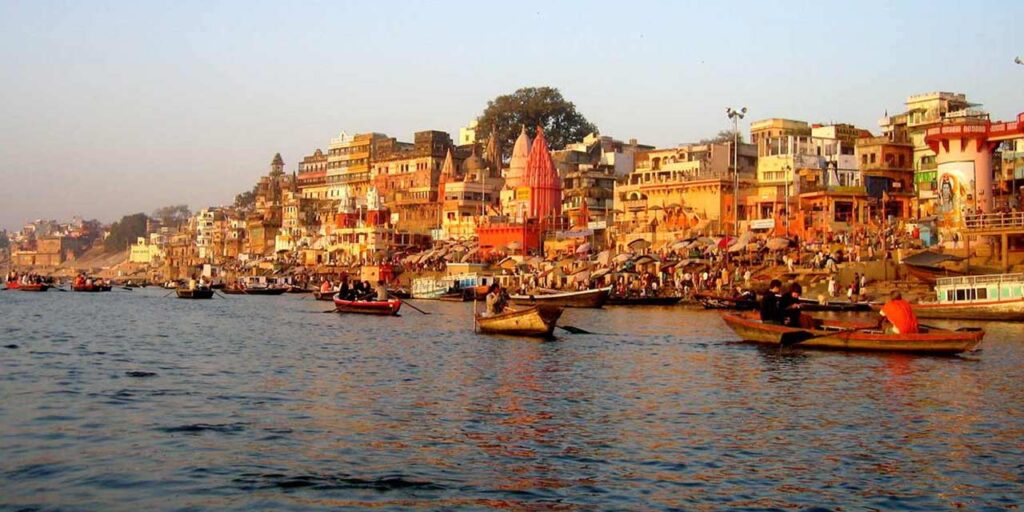
Dashashwamedh Ghat stands as Varanasi’s most famous and vibrant ghat. According to Hindu mythology, Lord Brahma performed the Dashashwamedh Yagna (ten-horse sacrifice) here. The ghat stretches approximately 100 meters, serving as the primary bathing site and spiritual center of the city.
The morning atmosphere at Dashashwamedh Ghat transcends description. Pilgrims immerse themselves in the sacred Ganges, priests perform rituals, and devotional chants fill the air. By evening, the Ganga Aarti ceremony transforms the ghat into a spiritual theater. Priests perform elaborate rituals with massive oil lamps, creating an hypnotic spectacle accompanied by drums and mantras. The ceremony, lasting approximately 45 minutes, represents the city’s soul.
Visiting Dashashwamedh Ghat early morning, around 5-6 AM, provides the most spiritual experience. You’ll witness authentic religious practices before tourist crowds arrive. Boat rides from this ghat offer spectacular perspectives of other ghats and the city skyline. Photography opportunities abound, though respecting people’s privacy during religious moments is paramount.
Manikarnika Ghat
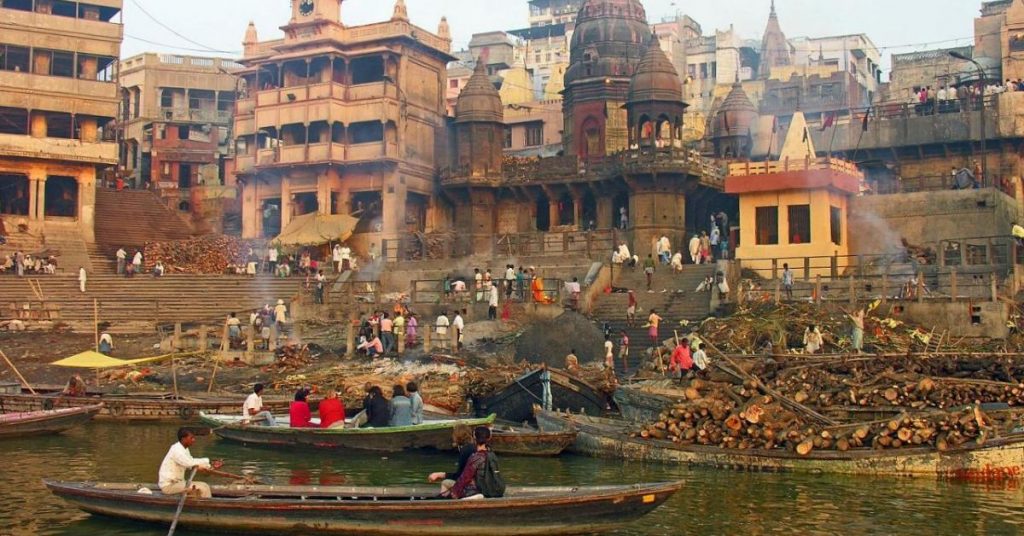
Manikarnika Ghat represents Varanasi’s most sacred cremation site. According to Hindu belief, bodies cremated here lead directly to moksha. The ghat operates continuously, and the spiritual significance of witnessing life’s final rites creates profound introspection for many visitors.
Approaching Manikarnika requires sensitivity and respect. This isn’t a tourist attraction but a sacred site where families perform last rites for deceased loved ones. However, many visitors approach with reverence and deep spiritual intention, finding the experience transformative. Local guides can explain the cremation process and its spiritual significance contextually and respectfully.
The ghat extends into the river, where funeral pyres burn continuously. The atmosphere carries significant weight and emotional intensity. Photography is generally discouraged, though some visitors respectfully capture images from distance. Coming here provokes contemplation about mortality, impermanence, and life’s ultimate truths—core themes in Hindu philosophy.
Kashi Vishwanath Temple
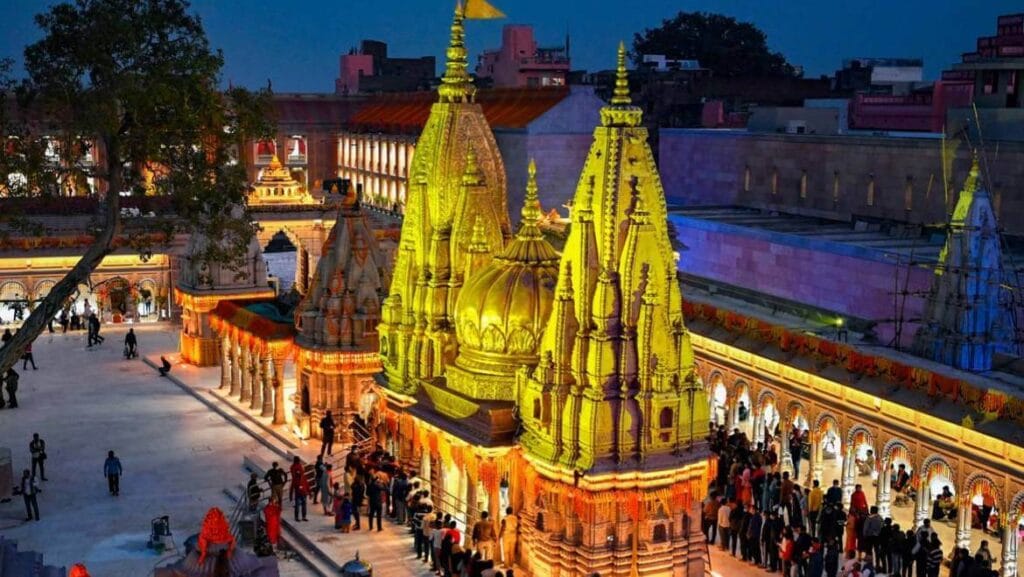
The Kashi Vishwanath Temple stands as one of India’s most important Hindu shrines. Dedicated to Lord Shiva, the temple’s main spire rises prominently over the city, visible from the Ganges. The temple’s history spans centuries, with several reconstructions following Mughal period destructions.
Visiting the temple requires navigating narrow streets lined with shops and vendors. The inner sanctum houses the Jyotirlinga, one of twelve sacred lingas representing Lord Shiva. The experience inside is intensely crowded, particularly during peak hours, but deeply devotional. Many pilgrims queue for hours to receive darshan (spiritual viewing) of the deity.
The temple’s architecture reflects classical Hindu temple design with intricate carvings and gold-plated spire. Adjacent to the main temple stands the Gyan Vapi Well, considered extremely sacred. The whole temple complex pulses with spiritual energy, drawing millions annually. Visiting early morning, between 5-7 AM, allows better access with fewer crowds and a more meditative atmosphere.
Sarnath
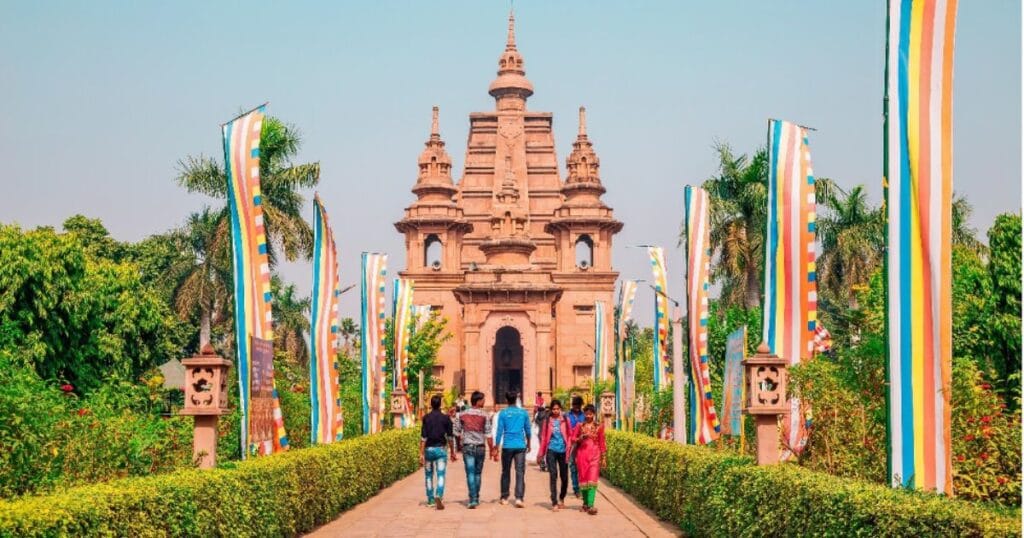
Located approximately 10 kilometers north of Varanasi, Sarnath holds immense significance in Buddhism. Buddha delivered his first sermon here after achieving enlightenment, establishing the Dhamma Chakra (wheel of dharma). The site encompasses several important Buddhist monuments and a peaceful atmosphere vastly different from urban Varanasi.
Sarnath’s main attraction is the Dhamek Stupa, an impressive cylindrical structure dating back over 2,000 years. The carved stone reliefs depict scenes from Buddha’s life and Buddhist teachings. The nearby Chaukhandi Stupa marks the spot where Buddha met his five disciples. The Sarnath Museum houses invaluable Buddhist artifacts, including sculptures and manuscripts.
The grounds radiate tranquility, with manicured gardens and meditation spaces attracting spiritual seekers and history enthusiasts. Several temples representing different Buddhist traditions operate here, creating interfaith harmony. A day trip to Sarnath provides insight into Buddhism’s historical roots and offers respite from Varanasi’s intense urban energy.
Ramnagar Fort
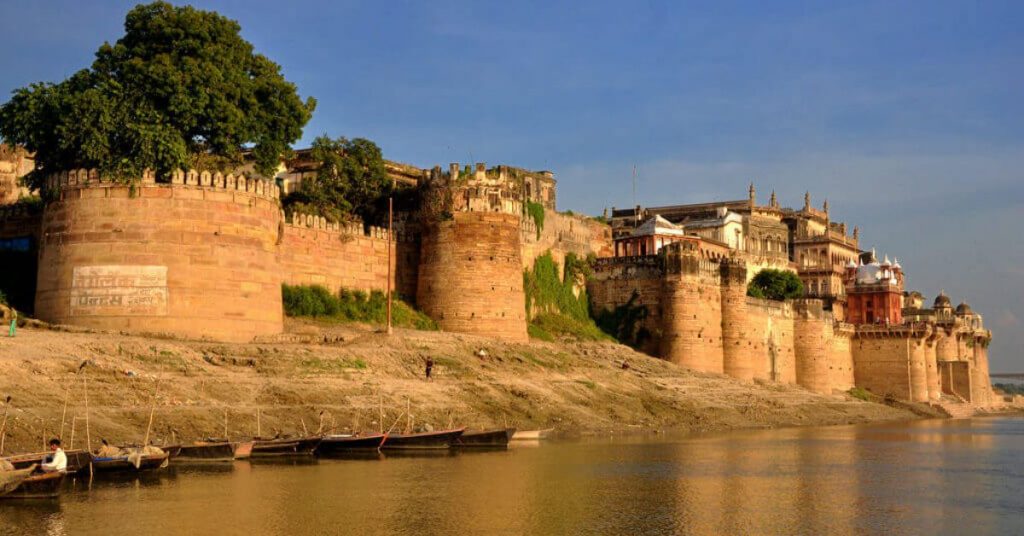
Standing on the eastern bank of the Ganges, Ramnagar Fort provides a different perspective on Varanasi’s historical narrative. Built in the 18th century by the Maharaja of Varanasi, the fort remains partially a royal residence with its eastern wing functioning as a museum.
The museum contains impressive collections of ancient weapons, royal regalia, manuscripts, and artifacts from the royal family’s collections. The fort’s architecture blends Mughal and Indian styles, evident in its sturdy walls and ornate gates. From the fort’s walls, you’ll gain panoramic views of the ghats and river, providing excellent photography opportunities.
Accessing the fort requires crossing the Ganges by boat, adding adventure to the visit. The journey itself offers insights into river life and alternative perspectives of the city. The less-crowded fort atmosphere suits those seeking quieter exploration. Entry fees are minimal, making it an economical yet enriching addition to your Varanasi travel guide itinerary.
Local Experiences & Authentic Cultural Activities
Beyond famous attractions, Varanasi’s true essence reveals itself through local experiences. These activities connect you deeply with the city’s culture and people.
Early Morning Boat Rides on the Ganges

Beginning your day with a boat ride on the Ganges captures Varanasi’s spiritual morning ritual. As dawn breaks, thousands of pilgrims descend to the ghats for ritual bathing. Priests perform morning prayers, and the city awakens to devotional chanting.
Boat rides typically last 60-90 minutes and cost approximately 200-500 rupees per person depending on boat type and negotiation. Private boats allow leisurely exploration, while shared boats offer more economical options and opportunities to meet fellow travelers. The morning light creates golden tones across the water and ancient buildings, offering photographers unparalleled opportunities.
During the boat ride, observe how locals interact with the Ganges—with reverence, faith, and deep spiritual connection. You’ll witness pilgrims completing sacred rituals, priests performing ceremonies, and the city’s spiritual heartbeat exposed authentically. This experience fundamentally alters many visitors’ perspectives on spirituality and community.
Street Food Tours and Culinary Exploration
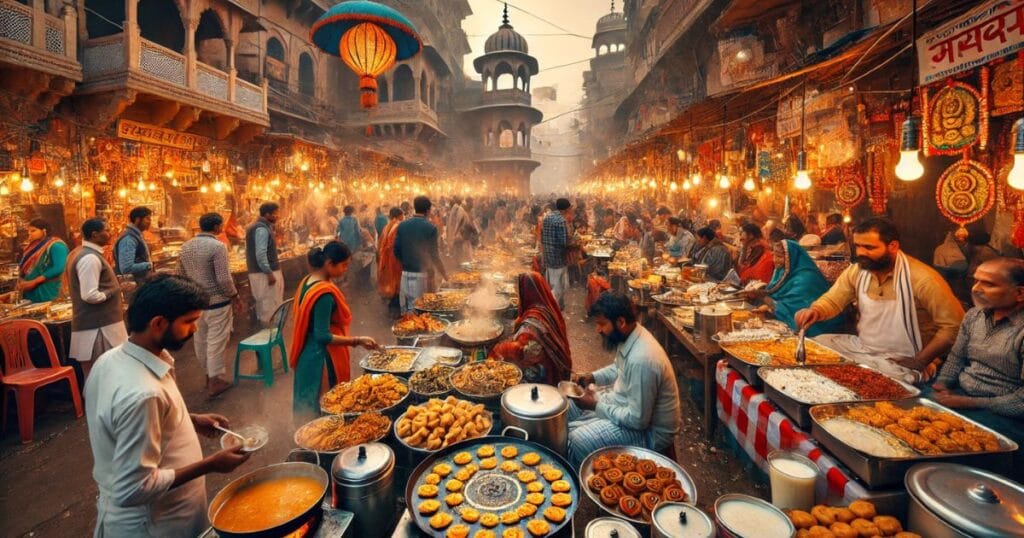
Varanasi’s street food culture represents one of India’s richest gastronomic traditions. Exploring the city’s lanes with local food guides introduces you to authentic flavors, family recipes passed down generations, and the stories behind beloved dishes.
Popular street foods include jalebis (spiral-shaped sweets), pani puris (crispy shells with seasoned water), kachauris (deep-fried pastries), and lhassi (yogurt-based beverages). The Godaulia area buzzes with food vendors, while Assi Ghat offers diverse culinary experiences. Many food tours also include visits to local markets, revealing how ingredients are sourced and prepared.
Engaging with vendors personally, understanding their family histories, and learning traditional cooking methods provides cultural depth beyond mere taste. Most street food costs between 10-50 rupees per item, making culinary exploration affordable. However, ensure vendors maintain good hygiene standards, and gradually introduce your stomach to local foods to avoid digestive upset.
Silk and Brocade Weaving Workshops

Varanasi earned international fame for its silk weaving traditions dating back centuries. Visiting active weaving workshops allows you to observe master weavers creating intricate brocaded silk sarees, scarves, and textiles.
These workshops operate throughout the city, particularly in the Chowk area. Weavers demonstrate their craft using traditional handlooms, explaining the complex processes involved in creating patterns and designs. You’ll understand the precision, patience, and artistic vision required for each piece. Many workshops offer opportunities to try weaving yourself or commission custom pieces.
Supporting these artisans directly through workshop purchases helps preserve traditional crafts threatened by industrial production. Prices vary based on intricacy and materials, ranging from affordable scarves to expensive traditional sarees. Visiting workshops connects you with Varanasi’s artisan heritage and provides meaningful souvenirs with stories attached.
Yoga and Meditation Retreats
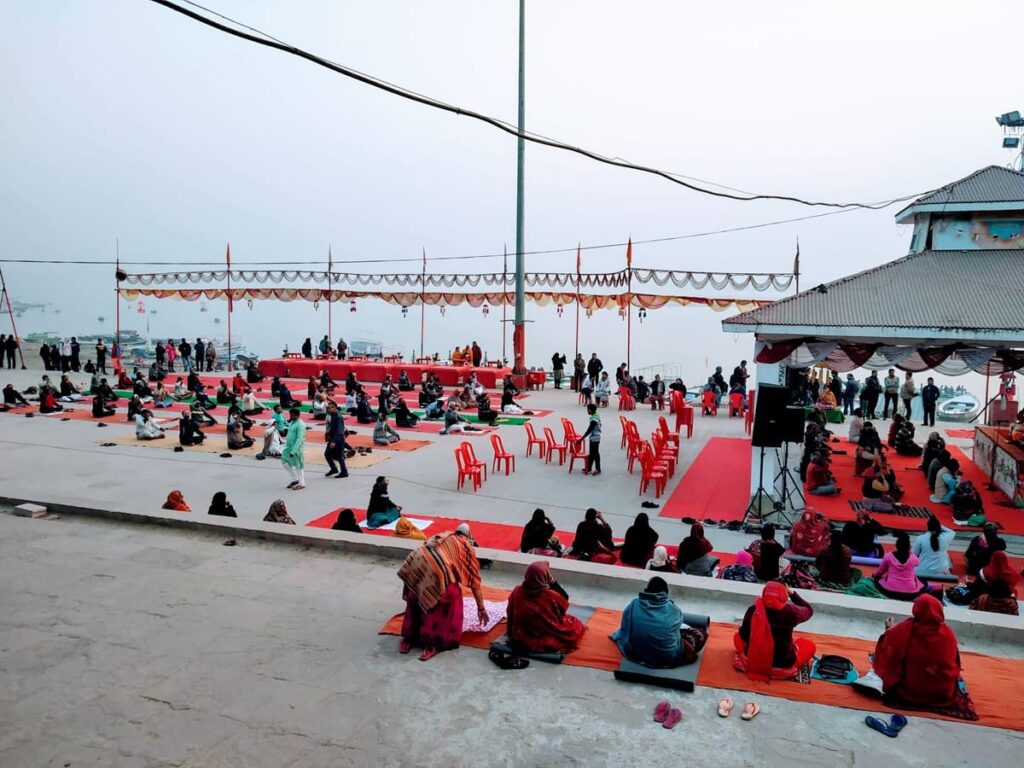
Varanasi hosts numerous yoga centers and meditation retreats catering to varying experience levels. The spiritual atmosphere and traditional yoga lineage make the city ideal for deepening practice.
Established centers offer drop-in classes, week-long courses, or month-long intensive programs. Classes typically begin at sunrise, incorporating asanas (poses), pranayama (breathing techniques), and meditation. Evening sessions often include philosophy discussions and spiritual teachings. Many centers operate on the ghats or in traditional buildings, enhancing the spiritual experience.
Costs range from 200-500 rupees per class to 5,000-15,000 rupees for week-long programs. Several centers offer donation-based classes, making yoga accessible regardless of budget. These retreats often connect you with like-minded seekers globally, creating communities extending beyond your Varanasi visit.
Where to Stay in Varanasi: Accommodation Guide
Varanasi offers diverse accommodation options catering to all budgets and preferences. Your choice significantly impacts your overall experience.
Luxury Hotels and Resorts
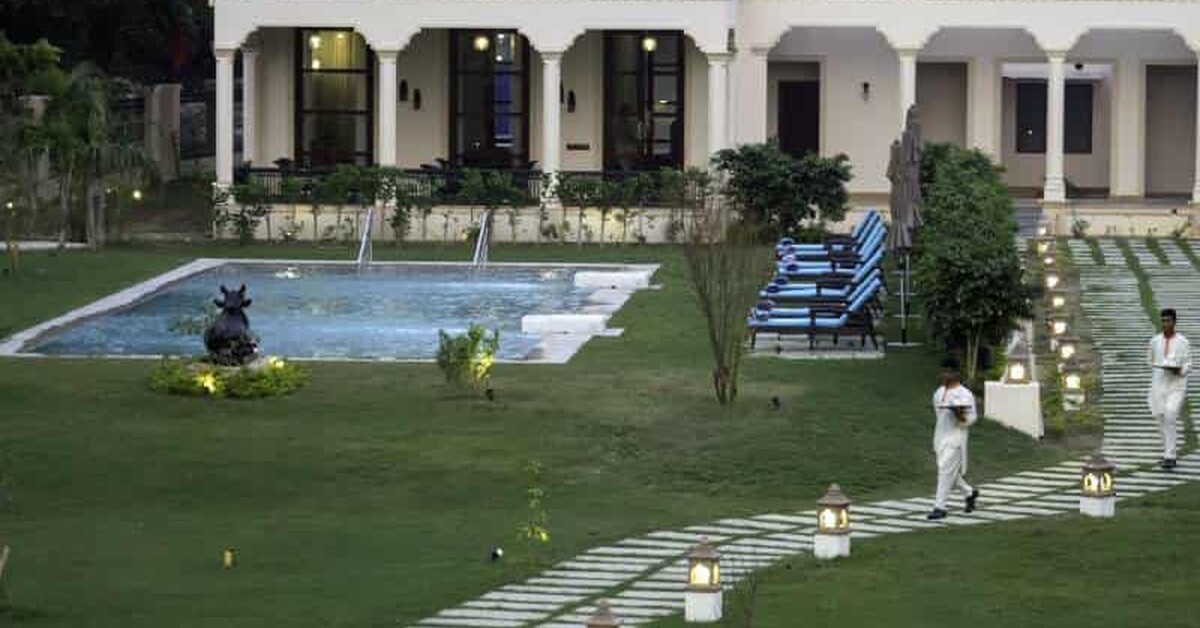
High-end hotels provide comfort, amenities, and often stunning river views. Properties like The Taj Gateway Hotel and Radisson Blu offer world-class facilities, fine dining, and personalized services. These accommodations typically cost 8,000-25,000+ rupees per night.
Luxury hotels provide excellent bases for exploring, with concierge services arranging tours and activities. Spa facilities, multi-cuisine restaurants, and modern amenities ensure comfortable retreats after day-long explorations. Rooftop restaurants often provide spectacular sunset and aarti ceremony views.
Mid-Range Hotels and Guesthouses
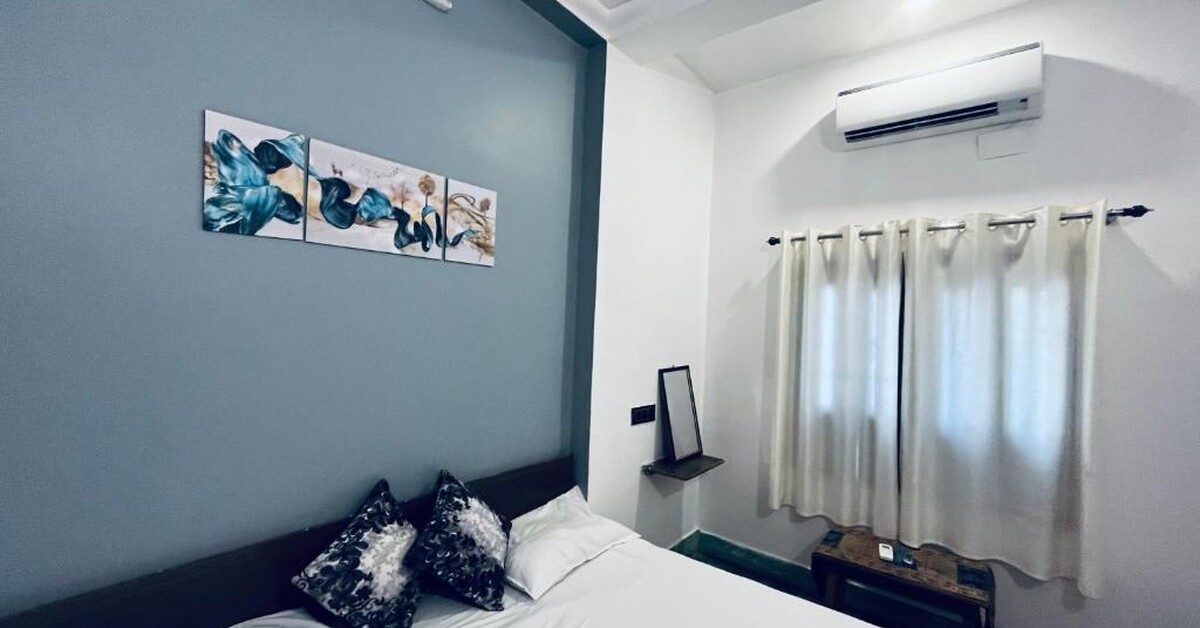
Mid-range accommodations strike excellent balance between comfort and cost, ranging from 2,000-8,000 rupees nightly. Hotels in this category maintain good standards while offering authentic experiences. Many family-run properties provide personal touches and local insights unavailable in larger chains.
Guesthouses, particularly prevalent near Assi Ghat, offer home-like atmospheres with knowledgeable owners eager to share Varanasi expertise. These properties often organize tours, cooking classes, or yoga sessions. Personal interactions with owners frequently result in recommendations and local knowledge enhancing your journey.
Budget Hostels and Homestays
For budget-conscious travelers, hostels and homestays offer 300-1,500 rupees per night accommodations. Hostels, particularly popular among young travelers, provide social atmospheres and opportunities to meet people. Homestays connect you with local families, offering cultural immersion and authentic daily life experiences.
Both options require tolerance for basic amenities and occasional noise. However, the savings allow extended stays and allocation of funds toward experiences. Many budget properties organize group activities like cooking classes or evening gatherings, creating communities among guests.
Ghat-Side Accommodations
Staying directly beside the Ganges, though often in older buildings, provides unparalleled river access. Waking to aarti ceremonies and boat ride convenience from your doorstep creates magical experiences. These properties range from budget to mid-range, depending on amenities and river views.
Ghat-side accommodations typically involve climbing multiple staircases and sharing facilities, but the trade-off seems worthwhile for direct Ganges access. The morning ritual of stepping out to witness sunrise over the river and pilgrims bathing below creates unforgettable moments.
Food & Culinary Delights: Varanasi’s Gastronomic Heritage
Varanasi’s cuisine reflects its geography, spiritual traditions, and cultural diversity. The city’s gastronomic landscape offers experiences beyond typical Indian food.
Traditional Vegetarian Cuisine
As a major pilgrimage destination, vegetarianism dominates Varanasi’s food culture. This doesn’t indicate limited options; rather, an incredible variety of vegetable-based dishes showcase creative Indian cooking.
Dal (lentil curries), paneer preparations, seasonal vegetable curries, and milk-based sweets form the culinary foundation. Family recipes developed over generations ensure authentic flavors in traditional restaurants. Thali meals, serving multiple dishes with rice and bread, provide comprehensive culinary experiences at economical prices (100-250 rupees).
Kachauri, a crispy fried pastry filled with spiced lentils, represents Varanasi’s signature breakfast item. Puri-aloo (fried bread with potato curry) and idli (steamed rice cakes) offer alternative breakfast options. These foods fuel pilgrims’ spiritual journeys while delighting taste buds.
Sweet Traditions and Desserts
Varanasi’s sweet shops create desserts ranking among India’s finest. Peda, a milk-based sweet, and barfi, made from condensed milk with various flavorings, are particularly renowned. These sweets, traditionally offered during prayers, carry spiritual significance beyond taste.
Kheer (rice pudding) and halwa (semolina or carrot-based pudding) appear frequently in temple offerings and special meals. These desserts, prepared with ghee and dry fruits, provide indulgent treats. Many families maintain sweet-making traditions, with recipes passed through generations.
Exploring traditional sweet shops, watching artisans prepare fresh batches, and sampling warm sweets straight from preparation provides sensory delights. Prices remain reasonable, with most sweets costing 50-150 rupees per serving.
Chikhalwali Tea Culture
Varanasi’s tea culture, while less famous than specialty coffee trends, holds charm and authenticity. Local tea vendors brew strong black tea with milk and spices, creating chai uniquely satisfying in this spiritual setting.
Sipping chai from clay cups beside the Ganges, watching life unfold along the ghats, creates meditative moments. Chai vendors operate throughout the city, with tea costing 10-20 rupees per cup. The social aspect of chai culture—gathering around vendors, engaging in conversations—reveals local daily life.
Restaurants and Dining Experiences
Varanasi’s restaurant scene ranges from traditional family-run establishments to modern cafes catering to international travelers. Assi Ghat area hosts numerous restaurants with river views, though prices run higher than local eateries.
Established restaurants like Café Varanasi and Pizzeria Varanasi offer multi-cuisine options alongside traditional Indian fare. These establishments maintain consistent quality standards suitable for travelers with sensitive stomachs. Mid-range restaurants typically charge 150-400 rupees per main course.
For authentic experiences, venture into narrow lanes where local restaurants serve traditional cuisine to primarily local clientele. These gems, while less polished, often deliver superior flavors and economical prices (50-200 rupees per meal).
Getting Around Varanasi: Transportation Guide
Navigating Varanasi requires understanding available transportation options and the city’s unique layout.
Boat Services
Boats provide primary transportation across the Ganges and represent quintessential Varanasi experiences. Auto-rickshaw-powered ferries operate on established routes, costing 5-10 rupees per crossing. Private boats and rowing boats, arranged through guesthouses or directly with boatmen, offer flexible exploration options.
Early morning boat rides during aarti preparation capture the city’s spiritual essence. Evening boat rides provide spectacular sunset views and evening prayer atmospheres. Boatmen typically charge 200-500 rupees for hour-long rides, with prices negotiable based on boat type and duration.
Auto-Rickshaws
Three-wheeled auto-rickshaws serve as primary land transportation. They’re economical, navigating congested areas impossible for larger vehicles. Rides typically cost 20-100 rupees depending on distance. While meter-equipped autos exist, negotiating fares beforehand prevents disputes.
Auto-rickshaws prove essential for reaching outlying areas like Sarnath or Ramnagar Fort. However, the city center’s narrow lanes accommodate only foot traffic, making walking unavoidable for ghat exploration.
Taxis and Ride Services
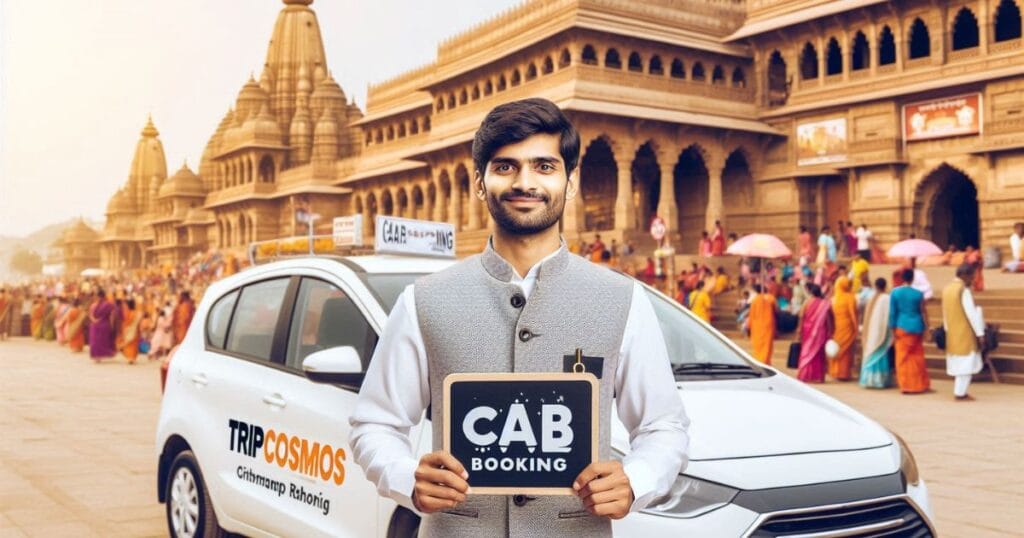
Pre-booked taxis provide comfort and reliability, costing approximately 10 rupees per kilometer. Ride-sharing apps operate in Varanasi, offering app-based bookings with transparent pricing. These options suit travelers preferring comfort over adventure.
For multi-day explorations or Varanasi travel guide activities like Sarnath day trips, hiring private taxis costs between 1,200-2,000 rupees daily depending on negotiations and vehicle type.
Walking
Walking remains the primary way to experience Varanasi’s lanes, discover hidden temples and shops, and interact with locals. The city’s pedestrian-focused layout makes exploring on foot not just viable but preferable.
Comfortable walking shoes, water bottles, and printed maps facilitate walking explorations. Early morning walks avoid heat and crowds while capturing peaceful city moments. Wandering seemingly randomly through lanes often yields unexpected discoveries—small temples, artisan workshops, local markets—creating authentic experiences.
Bicycle Rentals
Several shops rent bicycles for 50-100 rupees daily. Cycling offers good compromise between walking and motorized transport, though navigating congested areas requires confidence. Bicycles suit exploring outlying areas and less-crowded neighborhoods.
Practical Travel Tips for Varanasi
Successfully navigating your Varanasi travel guide requires practical knowledge and sensible preparations.
Visa and Documentation
Most foreign nationals require Indian visas before arrival. E-visas, obtainable online, suit most tourists. Processing takes 3-5 business days, costing approximately $25 USD. Tourist visas (T-category) remain valid 60-180 days depending on type.
Ensure your passport contains at least 6 months validity beyond your travel dates. Carry printed copies of visas, travel insurance documents, and accommodation reservations for reference.
Currency and Financial Matters
The Indian Rupee (INR) functions as currency, with exchange rates fluctuating daily. ATMs operate throughout the city, accepting international debit cards. Withdraw cash in moderate amounts to avoid excessive ATM fees.
Credit cards work in larger hotels and restaurants but not street vendors or small shops. Carry sufficient cash (500-2,000 rupees daily) for meals, transport, and purchases. Inform your bank of international travel to prevent card blocks.
Health and Medical Precautions
Vaccinations for Hepatitis A, Typhoid, and Japanese Encephalitis are recommended. Consult your doctor regarding malaria prophylaxis if visiting during monsoon season. Travel insurance covering medical emergencies provides essential protection.
Gastrointestinal issues are common among visitors. Drink bottled water only, avoid ice, consume cooked foods, and wash hands regularly. Common medications for stomach upset, motion sickness, and fever assist during travel. Consider visiting private clinics for medical concerns; public facilities vary significantly in quality.
Clothing and Packing Essentials
Pack weather-appropriate clothing based on your visit season. Summer demands light cotton clothes, sunscreen, and hats. Winter requires layers, light jackets, and sweaters for cool mornings. Monsoon season necessitates waterproof jackets and umbrellas.
Respect religious sensibilities by wearing modest clothing—knees and shoulders covered, avoiding transparent fabrics. This applies especially at temples and ghats. Comfortable walking shoes suited to potentially wet and uneven surfaces prove essential. Flip-flops work for casual exploration but shouldn’t replace proper footwear.
Respectful Behavior at Religious Sites
Varanasi’s religious nature demands visitors approach sacred spaces with respect and sensitivity. Remove shoes when entering temples, wait respectfully for priests’ directions, and photograph only with explicit permission.
At cremation sites like Manikarnika Ghat, approach with solemnity and compassion. Silent observation demonstrates respect for families performing sacred rites. The spiritual significance of these spaces supersedes tourist interests.
Respect posted signs prohibiting photography, maintain modest behavior, and follow local customs without questioning their logic. Your conduct reflects on all travelers and impacts locals’ welcoming attitudes.
Emergency Contacts and Resources
Important contact numbers: Police (100), Ambulance (102), Tourist Police (0542-2508872), and your country’s embassy or consulate.
Guidebooks, travel blogs, and tourism websites provide extensive information. However, local guides and hotel staff often offer most practical advice based on current conditions. Travel insurance customer service lines provide immediate assistance for emergencies.
Day Trip Destinations from Varanasi
Beyond Varanasi proper, surrounding areas offer enriching exploration opportunities.
Sarnath: Buddhism’s Pilgrimage Destination
Located 10 kilometers north, Sarnath represents Buddha’s first sermon location. The Dhamek Stupa, ancient Buddhist monuments, and peaceful meditation gardens attract pilgrims and history enthusiasts.
Half-day trips allow temple exploration and museum visits. Full-day visits enable leisurely site absorption and meditation time. Sarnath’s tranquil atmosphere provides rejuvenating contrast to Varanasi’s intensity. Entry fees typically cost 250 rupees for foreign nationals.
Ramnagar Fort
This 18th-century fort, accessible by boat crossing, provides historical insights into Varanasi’s royal heritage. The museum contains impressive artifacts, and palace grounds offer panoramic city views.
Two-hour visits suffice for basic exploration. Entry costs approximately 50 rupees. The less-crowded atmosphere and architectural beauty make it worthwhile despite modest attractions.
Prayagraj (Allahabad)
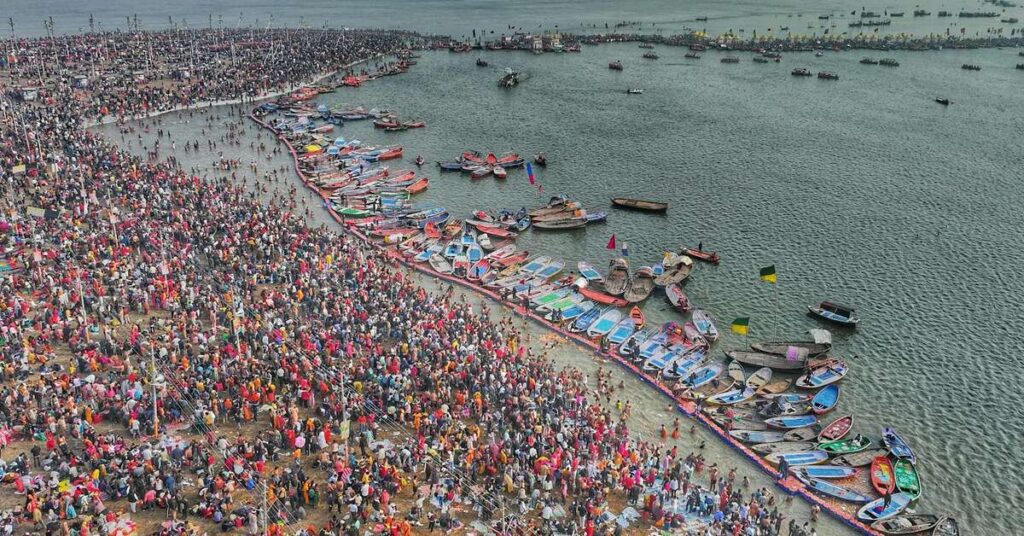
Approximately 120 kilometers away, Prayagraj hosts the Triveni Sangam—the sacred confluence of three rivers: the Ganges, Yamuna, and mystical Saraswati. The city holds immense significance in Hindu pilgrimage traditions.
The massive Kumbh Mela, occurring every 12 years, draws millions of pilgrims. Even outside Mela periods, visiting Triveni Sangam and Anand Bhavan (independence-era historical site) provides enriching experiences. Train journey takes approximately 2.5 hours.
Ayodhya
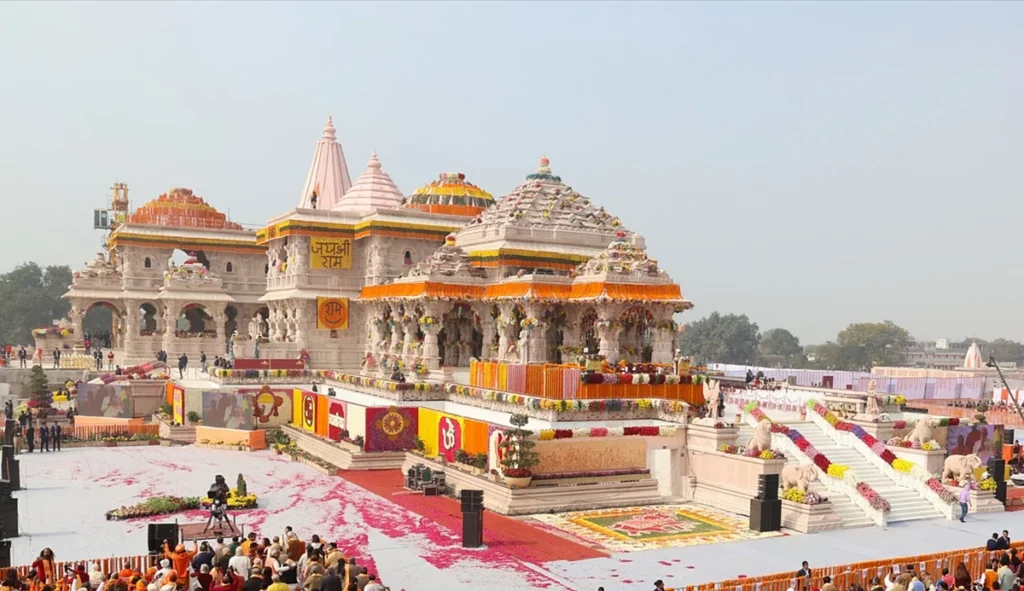
Approximately 130 kilometers away, Ayodhya represents another pilgrimage destination with profound Hindu significance as Lord Rama’s birthplace. The recently renovated Ram Mandir attracts millions of visitors globally.
Visiting Ayodhya requires overnight stays or early-morning departures. The journey involves approximately 3 hours travel. The new temple complex showcases architectural grandeur, while traditional sites provide spiritual experiences.
Frequently Asked Questions About Varanasi
Q1: Is Varanasi safe for solo travelers, especially women?
Yes, Varanasi is relatively safe for solo travelers, though certain precautions apply. Millions visit annually without incidents. Women travelers should practice standard safety measures: avoid isolated areas late at night, dress modestly, maintain awareness of surroundings, and trust instincts. Tourist police presence and numerous other visitors provide safety nets. Many women travelers report deeply positive experiences, finding locals respectful and helpful. Guesthouses can advise on safe routes and practices specific to current conditions.
Q2: What’s the best accommodation choice for experiencing authentic Varanasi?
Mid-range guesthouses operated by local families offer optimal balance between comfort and authentic experiences. These properties provide personal attention, local insights, and knowledge unavailable in larger chains. Ghat-side accommodations, despite basic facilities, connect you directly with Varanasi’s spiritual essence. Your choice depends on preferences—comfort-seekers might prefer established hotels, while cultural immersion seekers benefit from family guesthouses.
Q3: How much should I budget daily for Varanasi travel?
Budget varies based on accommodation choice and activities. Budget travelers manage on 1,500-2,500 rupees daily (accommodation, meals, basic activities). Mid-range travelers should allocate 3,000-6,000 rupees daily for comfortable stays and diverse activities. Luxury travelers spend 8,000+ rupees daily. Street food costs 20-50 rupees, meals 100-300 rupees, and most activities 200-500 rupees. Boats, guides, and workshops cost more but remain economical compared to Western destinations.
Q4: What’s the appropriate duration for Varanasi visit?
A minimum 2-3 day visit allows basic ghat exploration, main temple visits, and aarti ceremony attendance. Four to five days enable more comprehensive experiences including Sarnath, local cooking classes, and boat explorations. Spiritual seekers often spend weeks in yoga retreats or meditation programs. One day proves insufficient; you’ll only scratch the surface before departure. Most travelers report three to five days providing balanced experiences between main attractions and personal exploration.
Q5: Is the Ganges water safe for bathing?
The Ganges faces significant pollution challenges from industrial discharge and sewage. Hindus traditionally believe the river’s spiritual purity transcends physical contamination. For visitors, avoiding immersion is medically advisable unless you’ve received appropriate vaccinations and medical clearance. Watching pilgrims bathe remains spiritually moving without participating. If bathing, ensure shots against Hepatitis A, Typhoid, and maintain good hygiene practices afterward.
Q6: How should I approach cremation sites respectfully?
Approach cremation sites with reverence and compassion. Families performing these sacred rites are engaged in profoundly meaningful spiritual practice. Observe silently without photography, maintain respectful distance, avoid loud conversations, and never obstruct ceremonies. Understand your presence represents witnessing life’s most sacred moments. Local guides can explain processes contextually. Coming to these sites with genuine spiritual interest rather than morbid curiosity determines whether experiences feel respectful.
Plan Your Varanasi Journey with TripCosmos
Your Varanasi travel guide experience becomes seamless with professional tour support. TripCosmos.co, a renowned Varanasi tour company, specializes in customized travel packages across Varanasi, Ayodhya, Prayagraj, Lucknow, and surrounding destinations. Whether you’re seeking spiritual pilgrimage, cultural immersion, or adventurous exploration, TripCosmos tailors experiences matching your interests and schedule.
TripCosmos Services Include:
- Customized tour packages accommodating various budgets and durations
- Professional guide services providing historical, cultural, and spiritual context
- Comfortable cab booking and transportation arrangements
- Accommodation reservations at verified properties
- Pre-arranged cooking classes, yoga sessions, and artisan workshops
- Day trip organization to nearby destinations
Contact TripCosmos.co:
- Email: info@tripcosmos.co
- Phone: +91 9336116210
- Services: Tour packages, cab bookings, multi-city itineraries
Whether your Varanasi travel guide journey spans three days or extends to comprehensive multi-city exploration, TripCosmos provides expertise, reliability, and local knowledge ensuring unforgettable experiences. Their team understands Varanasi’s spiritual significance while maintaining tourist comfort, creating balanced itineraries honoring the city’s sacred essence.
Cultural Significance and Festivals in Varanasi
Diwali Festival
Diwali, the Festival of Lights, transforms Varanasi into a spectacular celebration. Celebrated in October or November, Diwali marks the triumph of light over darkness and good over evil. The entire city adorns itself with oil lamps, colorful decorations, and festive illuminations.
The ghats become particularly magical during Diwali. Thousands of oil lamps float on the Ganges, creating ethereal landscapes reflecting spiritual light. Temples overflow with devotees performing prayers and offering sweets. Local markets bustle with activity as shoppers purchase sweets, clothes, and gifts. The Ganga Aarti during Diwali becomes extraordinarily grand, with intensified ceremonial performances and larger crowds.
Visitors during Diwali experience Varanasi’s celebratory spirit firsthand. However, accommodation becomes scarce, prices increase substantially, and crowds intensify significantly. Booking accommodations months in advance becomes essential for Diwali visits.
Makar Sankranti
Celebrated in January, Makar Sankranti marks the sun’s transition into Capricorn and the beginning of spring. The festival holds particular significance in Varanasi, with massive pilgrimage gatherings at the ghats.
On Makar Sankranti, millions congregate for ritual bathing in the Ganges, believing this day’s immersion provides exceptional spiritual benefits. The ghats become overwhelmed with pilgrims, creating unique spiritual energy. Traditional festivities include kite flying, sesame sweet consumption, and community gatherings.
Experiencing Makar Sankranti provides insights into Hindu spiritual practices and pilgrimage traditions. However, the enormous crowds (sometimes exceeding 2-3 million) require patience and crowd navigation skills. Safety precautions include maintaining physical contact with companions and avoiding peak hours.
Varanasi International Music Festival
Held annually in December, this festival showcases classical Indian music performances by renowned musicians. The event attracts global audiences and represents Varanasi’s cultural sophistication beyond religious aspects.
Performances occur at various venues, including temples and outdoor spaces. The festival provides opportunities to experience Indian classical music—raag, tabla, and sitar performances—in authentic settings. Many events remain free or offer affordable entry, making classical music accessible.
Celebrating Lord Rama’s birth, Ram Navami occurs in March or April. The festival generates spiritual fervor throughout Varanasi, with special prayers, processions, and celebrations at Ram temples.
Religious processions navigate city streets, featuring floats, music, and devotional singing. Temples remain open for extended hours, and special aarti ceremonies commemorate the occasion. The celebration emphasizes Hindu mythology and spiritual devotion.
Photography and Visual Perspectives
Varanasi offers extraordinary photography opportunities, from sunrise aarti ceremonies to ancient architectural details.
Golden Hour Photography
Early morning light transforms the ghats into photographers’ paradise. The soft, golden sunlight creates flattering tones for both architecture and human subjects. The interplay of light and shadow on temple spires, reflected on river waters, produces exceptional images.
Sunset photography equally captivates, with evening light casting warm hues across the city. The Ganga Aarti ceremony provides dramatic subjects—priests with oil lamps, smoke rising, devotional crowds. These moments demand respect for religious ceremonies while capturing their beauty ethically.
Street and Cultural Photography
Varanasi’s narrow lanes teem with compelling subjects—vendors, children playing, craftsmen working, pilgrims in prayer. These authentic moments reveal daily life and cultural richness. However, photographing people requires permission and sensitivity, particularly for vulnerable populations.
Always respect photography restrictions at temples and cremation sites. Some locals prefer not being photographed; accept their wishes gracefully. Photography serves as a tool for remembering and sharing experiences respectfully, not exploitative documentation.
Architectural Documentation
Ancient temples, restored structures, and historical sites provide architectural interest. The intricate carvings, spire designs, and spatial arrangements reflect centuries of artistic evolution. Detailed macro photography captures fine craftsmanship invisible to casual observation.
Language and Communication
Hindi and Local Languages
While English serves as India’s official second language, speaking Hindi enhances interactions significantly. Learning basic phrases—greetings, thanks, directions requests—demonstrates respect and often generates warmer local responses.
Many Varanasi residents speak English, particularly those in tourism sectors. However, venturing into local areas requires basic Hindi or use of translation apps. Simple gestures and smiles transcend language barriers.
Practical Communication Tips
Carry translation apps for complex communications. Printed lists of essential phrases assist in restaurants and shops. Local SIM cards with data enable immediate translation access. Tourist police speak English and assist with complex communications.
Sustainable and Responsible Travel
Environmental Considerations
The Ganges faces significant pollution challenges, making environmental consciousness crucial during visits. Minimize plastic use by carrying reusable bottles, bags, and containers. Support businesses practicing sustainable operations and minimal waste generation.
Participate in river cleanup initiatives offered by some tour operators and environmental organizations. Choose eco-friendly tour companies prioritizing conservation. Your consumption choices impact local environments—select sustainably sourced products and ethical tourism practices.
Supporting Local Communities
Purchase directly from artisans rather than middlemen, ensuring benefits reach creators. Hire local guides, eat at family-run restaurants, and stay at locally-owned guesthouses. These choices sustain communities and preserve authentic experiences.
Respect cultural practices without appropriating them. Learn about traditions respectfully without attempting to participate in sacred rituals uninvited. Your respectful presence and financial support serve communities better than intrusive participation.
Volunteer Opportunities
Organizations throughout Varanasi welcome volunteers for community service, environmental projects, and educational initiatives. Volunteering provides deeper cultural understanding while contributing meaningfully to communities. Opportunities range from teaching English to environmental cleanup activities.
Post-Visit Reflection and Connection
Processing Your Experience
Varanasi’s intensity can feel overwhelming initially. After departure, reflecting on experiences helps integrate profound learnings. Journaling impressions, reviewing photographs, and discussing experiences with travel companions helps processing emotional and spiritual impacts.
Many visitors find themselves contemplating life’s fundamental questions long after leaving. Varanasi’s emphasis on impermanence, spirituality, and human resilience creates lasting philosophical impressions influencing life perspectives.
Maintaining Connections
Virtual tours and online resources maintain connections with Varanasi. Following pilgrimage sites on social media, reading travel blogs, and connecting with fellow travelers extends the journey. Many spiritual seekers maintain ongoing relationships with ashrams and yoga centers through online practice groups.
Returning to Varanasi
For many travelers, one visit initiates an ongoing relationship with the city. Annual or periodic returns deepen understanding and spiritual practice. Each visit reveals different layers, introduces new communities, and offers fresh perspectives on previously experienced phenomena.
The city welcomes returning seekers, treating them as pilgrims rather than tourists. Long-term practitioners and regular visitors form communities transcending typical tourist relationships.
Advanced Travel Strategies
Avoiding Common Tourist Traps
While Varanasi welcomes tourists, certain practices exploit unfamiliarity. Avoid unsolicited guide services offering suspiciously discounted rates or pressuring immediate decisions. Established tour operators maintain reputation through quality services, not high-pressure tactics.
Be cautious of restaurant servers steering you to specific establishments for commissions. Independent exploration and local recommendations prove more reliable. Research reviews before booking accommodations or services.
Off-Season Travel Benefits
Visiting during shoulder seasons (early March, late November) offers benefits of both peak and off-season periods. Weather remains pleasant, accommodations are available, but crowds diminish and prices decrease substantially compared to peak season.
Monsoon season visitors experience fewer tourists, economical prices, and authentic atmospheres. However, waterlogging in certain areas and limited outdoor activities require flexibility and acceptance of weather-dependent adjustments.
Extended Stays and Deeper Engagement
Staying 7-14 days enables genuine cultural immersion rather than surface tourism. Longer stays allow attending multiple aarti ceremonies, taking yoga courses, exploring beyond famous attractions, and developing authentic local relationships.
Multi-week stays facilitate spiritual practice, language learning, or artisan apprenticeships. These extended engagements transform Varanasi from destination to temporary residence, fundamentally altering experience quality.
Health, Wellness, and Self-Care in Varanasi
Yoga and Ayurveda
Beyond conventional yoga classes, Varanasi offers authentic Ayurveda treatments—traditional Indian medicine addressing holistic wellness. Consultation with qualified practitioners enables customized treatments addressing specific health concerns or preventive wellness.
Ayurvedic massages, herbal remedies, and dietary recommendations align with India’s ancient wellness traditions. Many yoga centers incorporate Ayurvedic principles, creating integrated wellness approaches.
Managing Physical Demands
Varanasi’s intensity—crowded streets, steep ghat steps, intense spiritual energy—can be physically demanding. Adequate hydration, rest periods, and realistic activity planning prevent exhaustion. Listen to your body and adjust schedules accordingly.
Spending entire afternoons in guesthouses or cafes, practicing meditation, or simply resting proves productive despite seeming inactive. This allows processing experiences and maintaining physical reserves for continued exploration.
Mental and Emotional Wellbeing
Varanasi’s spiritual intensity and exposure to mortality can evoke strong emotions. Journaling, meditation, or conversations with fellow travelers help process experiences. Many find spiritual or wellness practices beneficial for emotional grounding.
If feeling overwhelmed, reduce activity intensity, spend time in quieter areas like Sarnath, or temporarily focus on lighter experiences. Emotional responses to sacred sites and spiritual environments are normal; self-compassion during these processes proves important.
Comparison with Other Indian Destinations
Varanasi vs. Agra
Agra centers on architectural monuments—the Taj Mahal and Agra Fort—attracting primarily architecture and history enthusiasts. Varanasi focuses on spiritual experience and living culture. Both deserve separate visits for distinct experiential benefits.
Agra requires 1-2 days for comprehensive monument exploration. Varanasi deserves minimum 3-4 days for meaningful engagement. Combined itineraries work well for comprehensive North India experiences.
Varanasi vs. Rishikesh
Rishikesh, another Ganges-side destination, emphasizes yoga, adventure sports, and spiritual practice within more organized, structured environments. Varanasi emphasizes traditional pilgrimage, cremation practices, and authentic daily spirituality with less commercialization.
Rishikesh suits yoga enthusiasts seeking structured retreats. Varanasi suits those seeking immersive spiritual experiences and cultural exploration. Both destinations reward visits; choice depends on travel priorities and interests.
Varanasi vs. Jaipur
Jaipur showcases Rajasthani palace architecture, desert landscapes, and royal heritage. Varanasi emphasizes spiritual significance and ancient traditions. Jaipur attracts architecture enthusiasts; Varanasi attracts spiritual seekers.
A comprehensive North India itinerary includes both destinations, each contributing distinct cultural and experiential elements to overall journeys.
Conclusion: Carrying Varanasi Forward
Varanasi transcends conventional travel destinations. This ancient city, pulsing with spiritual energy and cultural richness, transforms visitors profoundly. The combination of sacred Ganges, thousands of temples, spiritual seeking masses, and authentic local experiences creates transformational opportunities unavailable elsewhere.
Your Varanasi travel guide journey, whether spanning days or weeks, leaves indelible marks. You’ll return home changed—carrying new perspectives on spirituality, death, impermanence, and human resilience. The early morning aarti ceremonies, conversations with pilgrims, tastes of traditional sweets, and boat rides at sunset become cherished memories sustaining you long after departure.
The best time to visit Varanasi aligns with your personal readiness for transformation rather than merely optimal weather conditions. Whether arriving during cool winter mornings or monsoon-softened afternoons, your presence in this sacred space initiates a unique journey reflecting individual needs and spiritual yearnings.
Plan your Varanasi visit thoughtfully, respect local customs and sacred spaces, engage authentically with locals, and remain open to unexpected discoveries. Whether you’re seeking spiritual awakening, cultural connection, historical understanding, or adventure, Varanasi delivers. The city’s invitation echoes across millennia: come experience life’s most profound moments, contemplate existence’s deepest mysteries, and connect with humanity’s universal spiritual yearning.
Your Varanasi travel guide experience awaits. Whether traveling independently or with professional support like TripCosmos, the journey promises transformation, learning, and spiritual awakening. The Ganges flows eternal, pilgrims continue their sacred rituals, and the city welcomes seekers from across the globe. Varanasi calls; will you answer?





